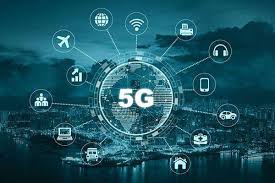info@gladsme.in
+91.8891968718
Exploring the Future: 5G Technology and Its Impact on Our Lives
Exploring the Future: 5G Technology and Its Impact on Our Lives

The world is on the cusp of a technological revolution with the advent of 5G technology. Promising faster speeds, reduced latency, and the ability to connect more devices simultaneously, 5G is set to transform various aspects of our lives. From enhancing mobile communications to enabling the Internet of Things (IoT), the potential applications of 5G are vast and profound. In this blog, we'll delve into what 5G technology is, how it works, its benefits, and the potential challenges it presents.
What is 5G Technology?
5G, short for fifth-generation wireless technology, represents the latest advancement in mobile networks. Unlike its predecessors, 5G aims to provide significantly faster data transfer rates, lower latency, and the capacity to connect a massive number of devices. This leap in performance is made possible through the use of higher frequency bands, advanced antenna technology, and improved network infrastructure.
How Does 5G Work?
5G technology operates on three spectrum bands: low-band, mid-band, and high-band (millimeter wave). Each band offers different advantages and trade-offs in terms of speed, range, and penetration:
Low-band spectrum: Offers broad coverage and penetration through obstacles but provides lower data speeds.
Mid-band spectrum: Balances speed and coverage, making it suitable for urban and suburban areas.
High-band spectrum (millimeter wave): Delivers ultra-fast speeds and low latency but has limited range and penetration capabilities.
To support these capabilities, 5G networks employ technologies such as massive MIMO (Multiple Input Multiple Output), beamforming, and network slicing.
Benefits of 5G Technology
Faster Speeds: 5G can deliver download speeds up to 100 times faster than 4G, making it possible to download high-definition movies in seconds.
Reduced Latency: Latency as low as 1 millisecond enables real-time applications like remote surgery, autonomous vehicles, and augmented reality.
Increased Connectivity: 5G can support up to a million devices per square kilometer, paving the way for the widespread adoption of IoT devices.
Enhanced Reliability: With improved network reliability, 5G ensures consistent performance even in crowded areas.
Applications of 5G Technology
Healthcare: Enables telemedicine, remote surgery, and real-time patient monitoring.
Smart Cities: Facilitates efficient traffic management, energy use, and public safety services.
Automotive: Supports the development of autonomous vehicles and vehicle-to-everything (V2X) communication.
Entertainment: Enhances virtual reality (VR), augmented reality (AR), and live streaming experiences.
Industrial IoT: Improves automation, monitoring, and control in manufacturing and logistics.
Challenges and Considerations
Despite its promise, 5G technology faces several challenges:
Infrastructure: Extensive infrastructure development is required, including the installation of small cells and upgrading existing network equipment.
Spectrum Availability: Access to the necessary spectrum bands is crucial for the widespread deployment of 5G.
Security: Enhanced security measures are needed to protect the increased number of connected devices and sensitive data.
Cost: The rollout of 5G networks involves significant investment, which may be a barrier for some regions.
5G technology holds the potential to revolutionize the way we live, work, and interact with the world around us. By offering unprecedented speeds, connectivity, and reliability, it will drive innovation across various industries and improve our daily lives. However, addressing the challenges and ensuring equitable access will be key to realizing the full benefits of this transformative technology.
Related Blogs

The Importance of Data Structures in Software Development
Read More...
Exploring Machine Learning Algorithms: A Beginner's Guide
Read More...
The Evolution of Programming Languages: From Assembly to Rust
Read More...
Understanding Big O Notation: A Guide for Developers
Read More...Subscribe for our Newsletter
Subscribe to elevate your software game! Stay updated on the latest trends, coding insights, and exclusive promotions with our newsletter.
